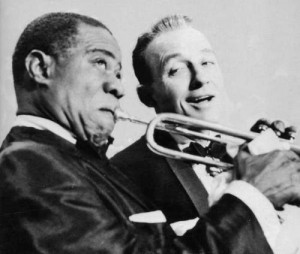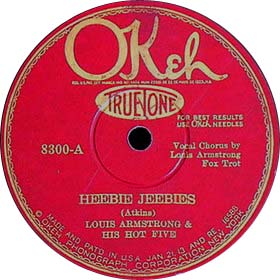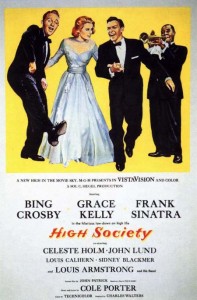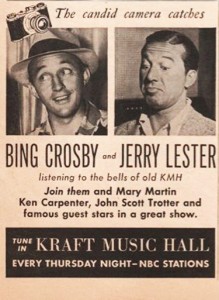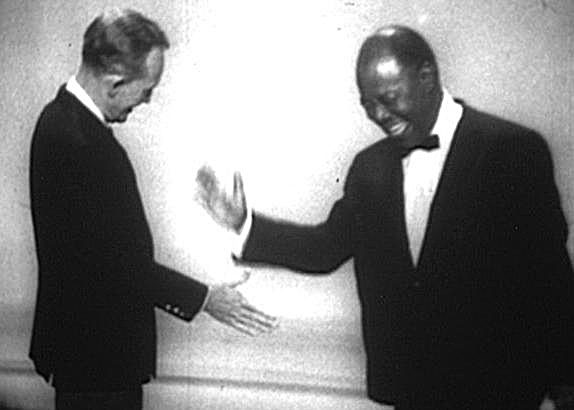Bing Crosby and Louis Armstrong struck up a friendship in the 1920s that flourished as they worked together for almost half a century on stage, in movies, and on radio and TV. This week Gary Giddins, author of Bing Crosby: A Pocketful of Dreams-the Early Years, 1903-1940 shares a look into the friendship between Bing and Louis.
In 1929 Bing Crosby was about to become the most famous pop singer in the country. He would score more number one hit records than anyone else in the 20th century—more than Elvis or even the Beatles. In the late 20s Louis Armstrong's star was on the rise too. His stunning trumpet playing and entertaining vocals were heard by millions on his widely influential recordings. Under the influence of Bing and Louis, pop music became infused with the rhythm and tonality of jazz and blues.
The two entertainers met for the first time in 1926 shortly after Bing signed with Paul Whiteman, the most popular act in show business, dubbed "The King of Jazz" by the press. Meeting up with his new boss on the road in Chicago, the first night Bing was in town he went over to the Sunset Cafe where Louis was holding forth. Gary Giddins says, "Crosby apparently could not believe his eyes or his ears, because what really knocked him out was that Armstrong would do one number that would practically bring you to tears, and then the very next number he’d put on this deacon’s coat and do an impersonation of a Deep South preacher and have everybody bowled over in the aisles."
Crosby was always impressed with Armstrong's singing, and according to Giddins it was late in life when Bing told a friend that Armstrong was "the greatest singer that ever was and ever will be." When his friend demurred, Crosby explained, "It’s so simple, when he sings a sad song you cry and when he sings a happy song you laugh. What the hell else is there in popular music?"
Like many singers of the late 1920s, Bing Crosby adopted the technique of "scat" singing (improvised vocal jazz soloing using rhythmic syllables instead of words) after hearing Armstrong's groundbreaking 1926 recording of "Heebie Jeebies."
The admiration between the two musicians was mutual. Louis Armstrong first heard Crosby when friends introduced him to recordings of Bing with the Rhythm Boys. Early in his solo career Bing learned to use the new electric microphone to his best advantage, perfecting a personal and intimate style of singing or "crooning." In 1930 Louis began to pick up on this style and would record a series of signature Crosby ballads—"Star Dust," "I Surrender, Dear" and "Wrap Your Troubles in Dreams"—in a crooning style. On live radio broadcasts Bing and Louis crooned their way into living rooms nationwide.
1930 was a breakout year for both artists, and they were both in Los Angeles heating up the club scene. Bing had left Whiteman and was in his debut run at the Cocoanut Grove, while Armstrong was appearing at Frank Sebastian's Cotton Club just down the street from MGM's Hollywood studios. Both gigs were broadcast live via remote hookup.
The friendship between Bing and Louis deepened during this period. Louis later wrote, "Every night between their outfit and our outfit, we used to burn up the air, every night...Yea, Bing and Gus Arnheim & Co. would broadcast first every night and leave the ether wave sizzling hot. Just right for us when we would burst on in there from the Cotton Club. Oh, it was lots of fun. The same listeners would catch both programs before going to bed."
In 1936 Bing was set to star in what would become one of the top-grossing films of the year, Pennies from Heaven. In spite of opposition from the producers, Bing insisted that Louis Armstrong be given a role and top billing in the film. It was the first time a black actor shared top billing with white actors in a major film. Armstrong's role in Pennies opened the door for appearances in seven more films that vastly increased his star power.
From the mid-1930s for a solid decade, Louis Armstrong and Bing Crosby were fixtures on the NBC radio series Kraft Music Hall. Bing hosted and Louis was his frequent guest. For both men, their entertaining and personable appearances on radio, in the movies and later on television would be far more important than their recordings in transforming them into much-loved, pop-culture icons of the 1950s and '60s.
Their movie collaborations culminated in 1956 with MGM's High Society starring Grace Kelly, Celeste Holm and Frank Sinatra with a score by Cole Porter. During the filming of the 1996 independent film Still Breathing, Ms. Holm told the Jim Cullum Jazz Band that her fondest memory of filming High Society was the constant presence on the set of Louis Armstrong and his All-Stars informally jamming and having fun.
And fun seems to have been the by-word whenever Louis and Bing got together, especially in their last appearances on television. Gary Giddins says, "...If you’re lucky enough...see the television performances they did together, especially on the Hollywood Palace where Bing puts his arms around him and they walk off into this long shadow together, and you feel like, it brings me almost to tears, these two amazing men walking back into the shadow of history who’ve really invented the music that we all love."
Photo credit for Home Page: Bing & Louis Havin’ Fun, 1951 Storyville Records. Photo courtesy indianapublicmedia.
Text based on Riverwalk Jazz script by Margaret Moos Pick © 2012


